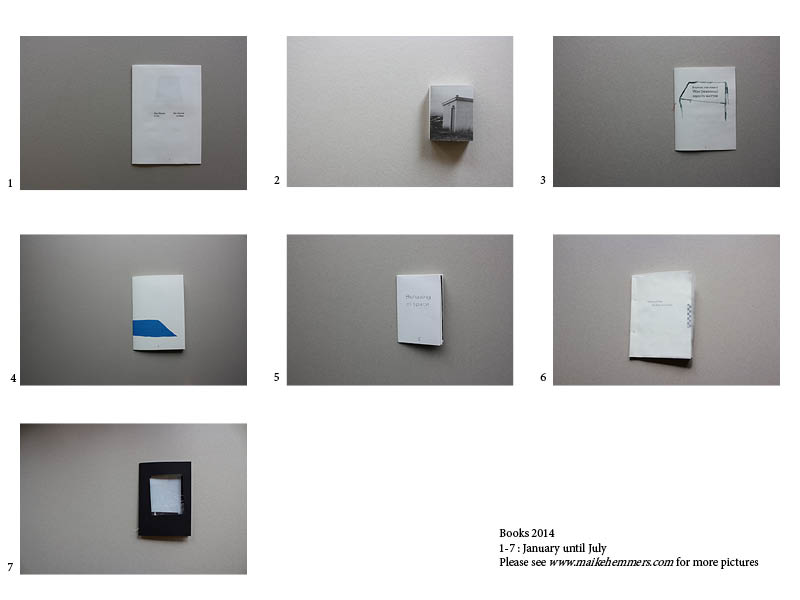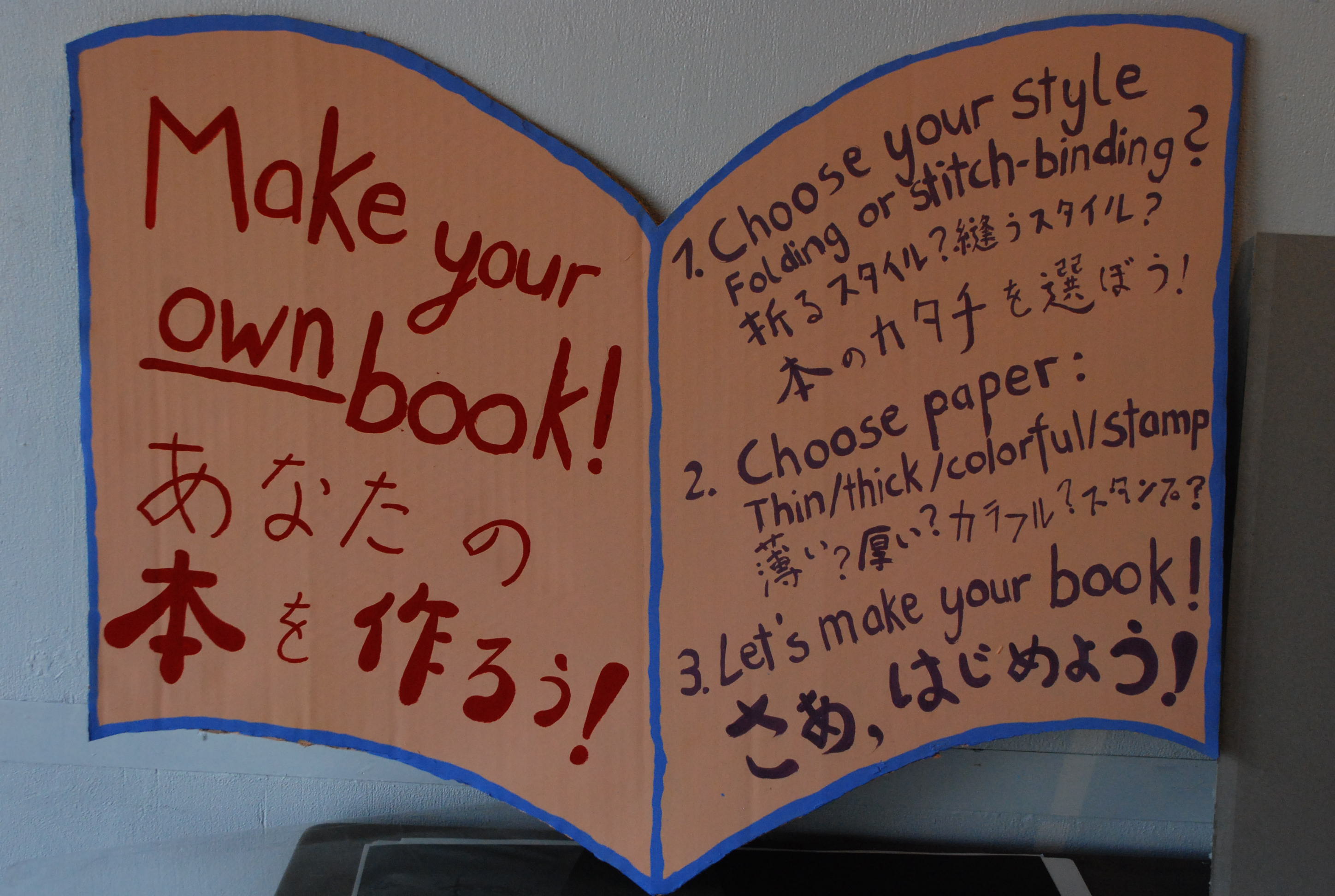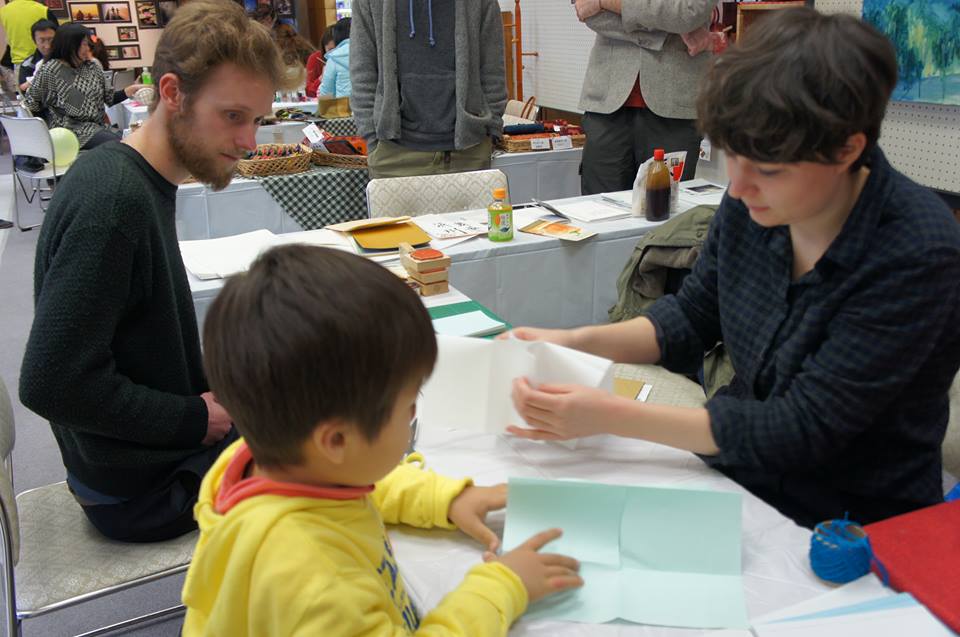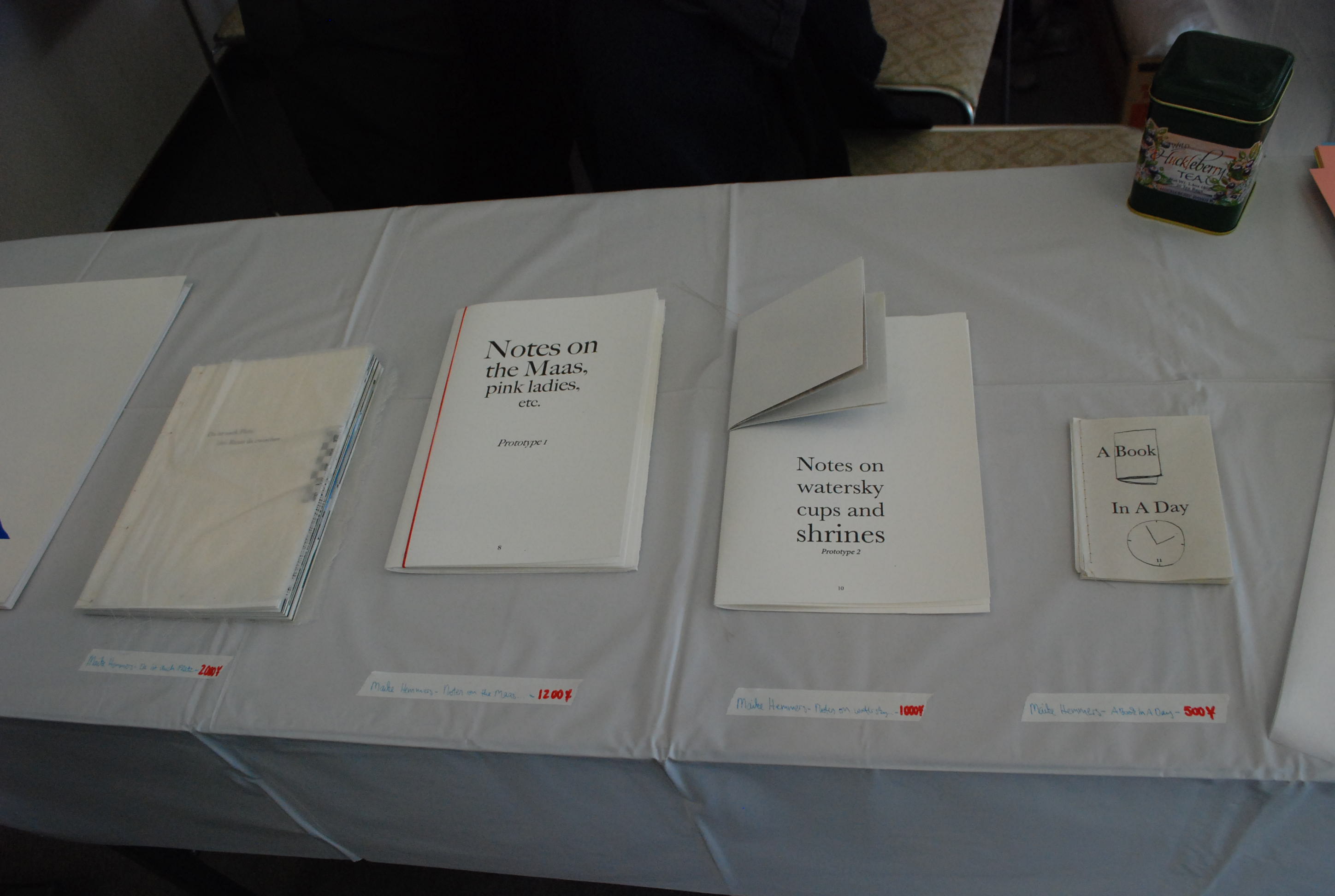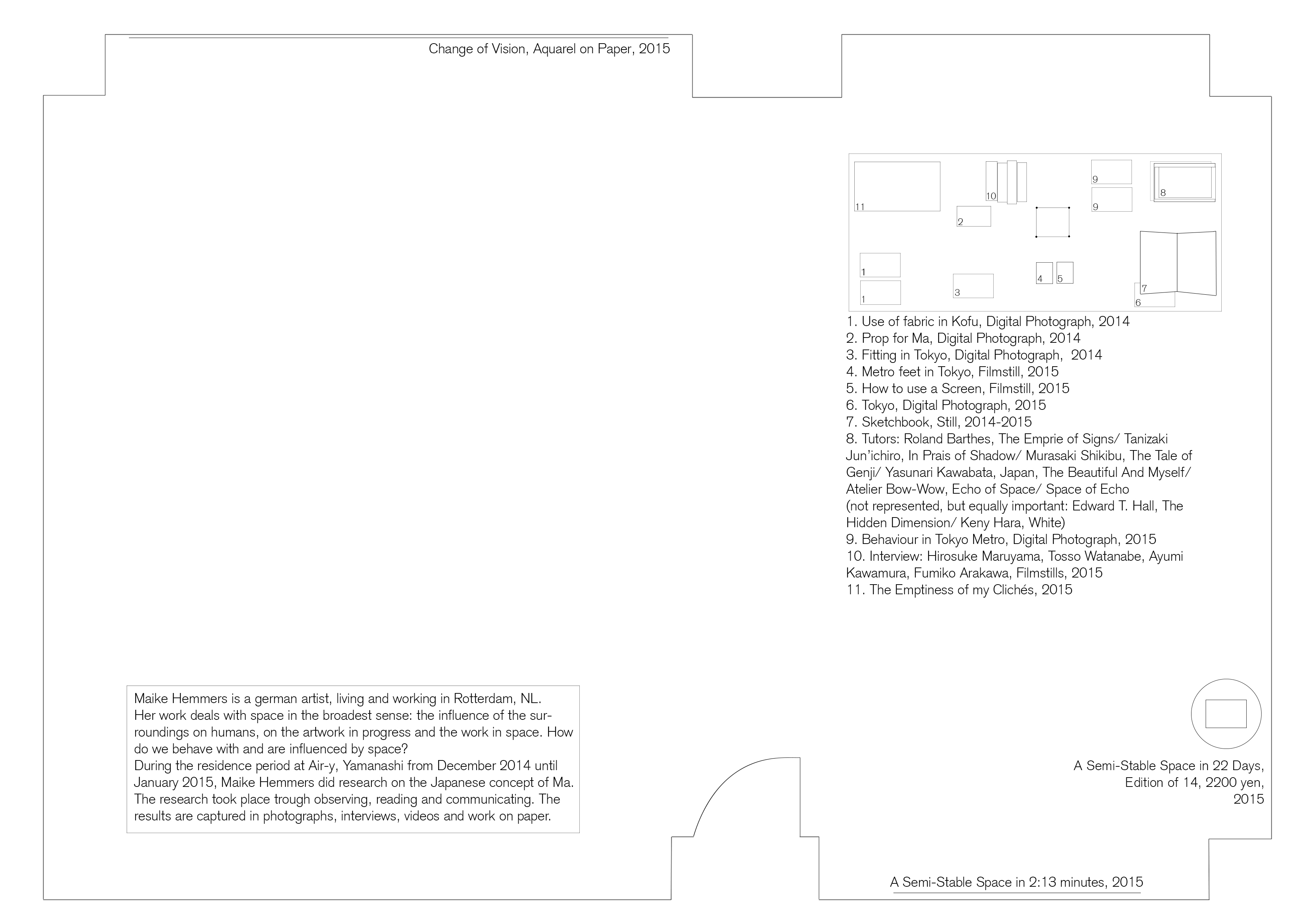born in German lives and works in Netherlands
work on paper, installation, books
www.maikehemmers.com
residency December 2014-January 2015
/
ドイツ生まれオランダ在住
紙に描画、インスタレーション、製本
2014年12月~2015年1月滞在
+
+
+

/
/
+
+
+
The everyday and the (visual) tactility of things is very fascinating for me. This fascination expresses itself mainly in two themes right now; the esthetic of everyday life and everyday objects and the interaction between the naturally unplanned and the conscious plan.
The esthetic of everyday life
The esthetic of everyday life is an essence for my art making. Everyday objects are represented in art, but art can also be represented in the everyday life. I can use this as an artist by making the everyday a context for my creating, for example as experience or starting point for creative activity. Through living the esthetic experience consciously you can change the everyday as a background of your existence to a foreground. The value of the everyday for me lies in the esthetic of my perception. I use this mainly in my work not by mirroring the everyday, but by taking it out of its context and making it notable. With that it gains a different meaning.
The everyday in art or art in the everyday is also an interesting point for the approach in making works if you consider the exclusivity of artworks. Making them less valuable makes them more approachable for a bigger audience. Creating editions in comparison to creating singular pieces gives them a wider range. By using books (as an everyday object) in my making as an artist I can literally use an everyday object in my art, that contacts the world.
Visual tactility
Visual tactility expresses itself in my work in the desire to touch. I want to touch physically or through looking at, touching visually with my eyes. Out of this focus I create work with a strong visual tactility. In this sense tactility means a communication on a sensual level. This can be expressed in the choice of material and the execution with them, but also in the way of presenting works. My wish for tactility expresses itself also in the topics I choose in my drawings such as (everyday) objects or the human body. In 2011/ 2012 I have made drawings related to body forms, the desire for tactility expressed itself literally in my chosen topics to draw. From 2013 onward the handling of this topic became more abstract, the desire to touch is mainly visible in the choice of material and the handling of that. Rough paper with a visible structure arises (at least for me) the craving to feel it and because of its structure has an almost three-dimensional effect. The patterns and color surfaces in my work give the impression of fabric or the structure of textile. In my book-making the visual tactility becomes physical by making an object, that is destined for use.
The naturally unplanned versus the conscious plan
Humans order the world through action and thoughts to their own means. Through cultivating they define nature to culture, however there is just a certain control you can gain over this nature. For me as an artist this implies, that I can make a plan for creating a work, yet this plan has its boundaries as the naturally unplanned factors influence the final result. This implies that a drawn line is influenced by the material you use (pen, paper, water etc) and the surroundings (placing, architecture, light etc). With that I question what happens to the so called autonomy of the artist if the work is not just formed by the cultural and social milieu, but also with the simple conditions of the material and the environment of presentation. About what kind of autonomy am I talking in my work then? I am interested in that ambiguity between my conscious plan/ autonomy as an artist and the unplanned/ autonomy of the surrounding world.
I examine this in my work by letting the naturally unplanned play a (more or less) conscious role in my work. The influence of material and surrounding is an equal partner in the making of an art work. This condition is examined in a visual manner, that expresses itself mainly in my choice of material in relation to working with drawings. The result of a working period in which I produce many drawings is put together in an exposition as installation where the connection of all these drawings becomes a whole work.
/
日常の物事の(視覚)触覚は私にとって非常に魅力的であり、主に2つのテーマがある。それは日常生活や日常のものごとと、自然な無計画と意識的な計画の間の美的な相互作用だ。
日常生活の美
日常生活の美は私のアート制作の基本だ。日常のものごとはアートの技術で表現されるが、アートも日常生活の中で表現することができる。わたしは経験として、たとえばアートのために日常の文脈を作ったり、創作活動を始める。美的体験を経ることは、意識的に自分の背景として経験が生かせるし日常を変えることができる。わたしにとっては日常の価値は知覚の審美にある。毎日の生活の表面を単に写すだけでなく、その文脈から切り取った注目に値することをわたしの作品に生かす。それは別の意味を得る。
日常の中のアートやアートの日常はまた、作品を作るアプローチのための興味深いポイントだ。より少ない貴重な作品を作ることはより多くの観客の関心を引く。ただ一冊の作品制作と比較して、もし版を作成すればより広い範囲に提供できるが。アーティストとして自分の意思で限定本を制作することによってわたしはアートで世界とつながることができる。
ビジュアル触覚
ビジュアル触覚とは、触れたいという願望を作品に表現していることを示す。わたしは物理的に自分の目で視覚的に触れたいと思い、強い視覚的な触覚を持つ作品を作成している。この官能的な触覚レベルでの表現を意味する。作品で提示しているように、素材の選択は現在の作品例に認められる。触覚へのわたしの願いについて、(日常の)オブジェクトや人体など図面で選択したトピックでも自分自身を表現している。2011-12年の作品で身体のフォームに関連する作品を作り自分を投影した。このトピックの取り扱いがより抽象的になった2013年以降は、触れたいという欲求は材料の選択とそれの取り扱いを中心に表示されている。ラフ紙目に見られる構造はほぼ3次元効果を持ち始めた。私の作品のパターンと色の表面は、布の印象または織物に構造を与える。わたしの本の中で作り上げられた視覚的な触覚は運命的な実体験といえる。
自然な無計画に対して意識的な計画
人間は自分の手段に行動や考えを通じて世界を理解する。例えば人間は植物を栽培することを通して文化への性質を定義するように、ある意味で制御がある。わたしにとってはアーティストが作品制作の計画を練ることを意味し、計画外の要因が最終結果に作品に影響を与える。これは引かれた線は使用材料(ペン、紙、水など)とその環境(配置、建造物、一般光)の影響を受けていることを意味する。また作品が文化的·社会的環境によってだけでなく、材料の単純な条件やプレゼンテーションの環境が形成されていない場合には、アーティストのいわゆる自律性に何かが起こるかもしれない。作品の中でわたしはどんな自律性を語るのか、アーティストと周囲の世界の無計画/自律性としての私の意識的な計画/自律性の間の曖昧さに興味を持っている。
制作の中では予定外の発展を多かれ少なかれ意識して役割をさせることを考える。材料と周囲の影響はアート作品の制作における対等なパートナーである。この条件は作品上の作業に関連し、材料の選択で自分自身を表現して視覚的な方法を検討する。レジデンス期間の最終段階で、これらすべての作品全体で構成されるインスタレーションとして発表する。
+
+
+
Maike Hemmers held a workshop
[make own book!]
@Yamanashi International Association
http://www.yia.or.jp/
11:00-15:30 Saturday 13th December
admission fee ¥500
/
/
/
/
/
/
/
/
Maike Hemmers open studio
[context in time]
/
マイケ・ヘマース オープンスタジオ
/
Hemmers has been interested in Japanese unique space perceptions before coming to Japan.
She would like to study the concept of “between” from writings of the original by Kenya HARA.
Then try to research from various fields about “間” that it is not in the Western concept.
In the open studio of two days a visual representation of the image toward this theme is installed in the studio.
/
ヘマースは来日前から日本独特の空間の捉え方に興味を持ち、原 研哉の著述から「間」の概念について研究したいと考えていました。
滞在中は西洋的概念にはないという「間」を多方面からリサーチを試みて、二日間のオープンスタジオではインスタレーション形式でそのイメージを視覚的に表現します。
/
リサーチと活動:
江戸時代中期の伝統的家屋「安藤家住宅」リサーチ
家具職人・華道家・書道家・アーティストへのインタビューと録画撮り
川端康成 書物研究
現在の居室空間を22日間撮影して編集製本した[semi stable place in 22 days] の出版
※[semi stable place in 22 days] 14冊限定出版
販売中 ¥2200/一冊
/
/
/
gallery map_open studio
/
change of vision, acrylic on paper
/
a semi-stable space, video in 2.13 minutes
/
a semi-stable space in 22 days, edition of 14
/
/

/

/
1-11, photos and books of studying Japanese concept Ma
/


